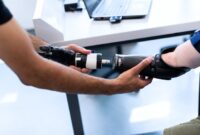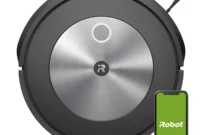Robotics has emerged as a groundbreaking field that is revolutionizing industries across the globe. The fusion of mechanical engineering, computer science, and artificial intelligence has given rise to advanced robots capable of performing complex tasks, leading to significant advancements in various sectors. In this article, we will explore the role of robotics in designing the future, uncovering its potential across different industries and addressing the ethical considerations and challenges associated with its rapid development.

1. Introduction to Robotics and its Significance in Designing the Future
In recent years, robotics has witnessed tremendous growth, enabling us to push the boundaries of what was once deemed possible. With robotics, we have the potential to enhance efficiency, productivity, and safety across industries, while also opening up new opportunities for human advancement. From healthcare and manufacturing to transportation and agriculture, the integration of robots has the power to transform the way we live and work.
2. The Role of Robotics in Various Industries
Robots are now indispensable tools in several industries, offering benefits such as increased precision, reduced costs, and improved safety. In the healthcare sector, surgical robots have revolutionized minimally invasive procedures, allowing for greater accuracy and faster recovery times. These advancements have led to improved patient outcomes and have made complex surgeries more accessible.
3. How Robotics is Reshaping Healthcare
In addition to surgical robots, robotics is reshaping healthcare in other areas as well. Robots are being utilized for tasks such as patient care, rehabilitation, and medication management. They can provide assistance to individuals with disabilities, helping them regain mobility and independence. Moreover, robots can gather and analyze patient data, aiding in the early detection of diseases and improving treatment plans.
4. Robotics in Manufacturing and Automation
One of the most prominent areas where robotics has made a significant impact is manufacturing and automation. Industrial robots are now common in factories, performing repetitive tasks with high precision and speed. By automating these processes, companies can enhance productivity, reduce errors, and optimize resource utilization. This trend is leading to the rise of smart factories, where robots work seamlessly alongside human workers, creating a harmonious collaboration.
5. Robotics and the Future of Transportation
The future of transportation is closely intertwined with robotics. Self-driving cars are becoming a reality, with companies investing heavily in autonomous vehicle technology. These vehicles have the potential to improve road safety, reduce traffic congestion, and enhance overall transportation efficiency. Moreover, the logistics industry is adopting robotics for tasks such as package sorting and delivery, further streamlining operations.
6. Robotics in Agriculture and Farming
The agriculture sector is leveraging robotics to address labor shortages and increase crop yields. Agricultural robots can perform tasks such as seeding, harvesting, and crop monitoring autonomously. They can also optimize resource usage by precisely applying fertilizers and pesticides, leading to more sustainable farming practices. With the help of robots, farmers can achieve higher productivity while minimizing environmental impact.
7. The Impact of Robotics on Education and Research
Robotics is playing a vital role in education and research, fostering innovation and experiential learning. Educational robots are being used in classrooms to teach programming, problem-solving, and critical thinking skills. Additionally, researchers are exploring the use of robots in scientific experiments, space exploration, and even disaster response scenarios. The integration of robotics in these fields is inspiring the next generation of scientists and engineers.
8. Ethical Considerations in Robotics Design
As robotics becomes more prevalent in our lives, ethical considerations come to the forefront. Designers and engineers must ensure that robots are programmed with ethical guidelines and adhere to principles that prioritize human safety and well-being. Furthermore, the potential impact of job displacement due to automation raises ethical questions that need to be addressed. Striking a balance between technological advancements and ethical responsibilities is crucial in the design of future robots.
9. Challenges and Limitations of Robotics
While robotics offers immense potential, there are challenges and limitations that need to be overcome. Technical hurdles, such as power limitations and sensor accuracy, pose obstacles in developing robots that can operate autonomously in various environments. Additionally, social acceptance and regulatory frameworks are areas that require attention to ensure the smooth integration of robots into society.
10. Advances in Artificial Intelligence and Machine Learning for Robotics
Advancements in artificial intelligence (AI) and machine learning (ML) have significantly contributed to the evolution of robotics. AI-powered robots can adapt to changing environments, learn from their experiences, and make intelligent decisions. ML algorithms enable robots to recognize objects, understand speech, and interact with humans more naturally. These advancements are propelling robotics into new realms of functionality and interactivity.
11. Collaboration between Humans and Robots
Contrary to the belief that robots will replace humans, collaboration between humans and robots is gaining momentum. Cobots, or collaborative robots, are designed to work alongside humans, complementing their skills and capabilities. This collaboration enhances productivity and safety while fostering a symbiotic relationship between humans and machines. As the technology advances, we can expect to see more instances of human-robot collaboration across various domains.
12. The Future of Robotics: Predictions and Possibilities
Looking ahead, the future of robotics appears promising. Experts predict that robots will continue to become more intelligent, adaptable, and integrated into our daily lives. From personal robots assisting with household chores to robotic companions providing emotional support, the possibilities are vast. However, careful consideration of the ethical implications and societal impact is crucial as we navigate the uncharted territories of advanced robotics.
13. Implications of Robotics on the Job Market
The rise of robotics inevitably raises concerns about job displacement and the future of work. While some tasks may be automated, the introduction of robots also creates new job opportunities. Instead of eliminating jobs entirely, robotics often leads to job transformation, where humans can focus on higher-level tasks that require creativity, critical thinking, and emotional intelligence. Preparing the workforce for these shifts is essential for a smooth transition.
14. The Importance of Interdisciplinary Collaboration in Robotics Development
Given the complex nature of robotics, interdisciplinary collaboration is vital for its development and progress. Experts from various fields, including engineering, computer science, psychology, and ethics, must come together to tackle the challenges and ensure that robotics aligns with human values and societal needs. By fostering collaboration and knowledge sharing, we can create a future where robots coexist harmoniously with humans.
15. Conclusion
Robotics is undoubtedly at the forefront of technological advancement, and its impact on designing the future is undeniable. From healthcare and manufacturing to transportation and agriculture, robots are transforming industries and shaping the way we live and work. However, as we navigate this future, it is crucial to consider the ethical implications, address challenges, and ensure that robotics development aligns with our values. With careful planning and interdisciplinary collaboration, we can design a future where robotics plays a transformative and positive role in society.
FAQs
- What is robotics? Robotics is a field that combines mechanical engineering, computer science, and artificial intelligence to design, build, and program robots capable of performing various tasks.
- How are robots reshaping healthcare? Robots are revolutionizing healthcare by assisting in surgical procedures, patient care, rehabilitation, medication management, and data analysis for improved diagnoses and treatments.
- What is the future of transportation with robotics? Robotics is driving the future of transportation with advancements in autonomous vehicles, self-driving cars, and robotics-based logistics systems for efficient and safe transportation.
- Are robots replacing human jobs? While automation and robotics may lead to some job displacement, they also create new job opportunities and transform existing roles, allowing humans to focus on higher-level tasks.
- What are the ethical considerations in robotics design? Ethical considerations in robotics design involve ensuring human safety, addressing job displacement, maintaining privacy and security, and upholding moral principles in programming and decision-making.


